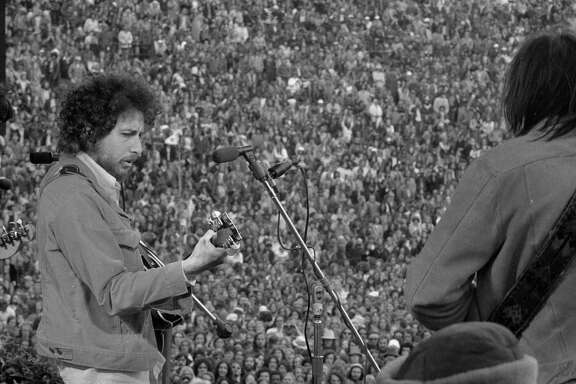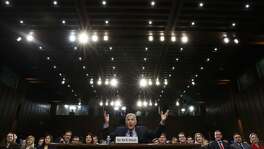This week’s topic: San Francisco rock concerts.
The SNACK benefit concert at Kezar Stadium in San Francisco was put together in a breakneck 3½ weeks, with appearances by Bob Dylan, Neil Young, Marlon Brando, Willie Mays and more.
A few days before the March 1975 concert, Chronicle columnist John Wasserman put in a call to Bill Graham. When the promoter answered, Graham sounded like he was on the verge of a nervous breakdown.
“John,” Graham told Wasserman, in a measured cadence. “I would clean … with Brillo pads … every stone in Madagascar … before I would do this again.”
The SNACK concert (Students Need Activities, Culture and Kicks), which raised $200,000 to save high school sports in San Francisco, was everything great about concerts in San Francisco. It was both a royal pain and a wild success. There was nothing like it before or since. And it continued the city tradition of artists and promoters who are willing to leave their comfort zones and put on a show that no one will ever forget.
We’ll set aside San Francisco opera, classical music, jazz and blues, which we’ll cover in future Our San Francisco installments. Looking at the past half century of rock and pop music performances, is there any city in the nation you would rather live in? Is there any city that has gotten more out of its homegrown talent, and seen so many artists from out of town step up their artistry to another level?
As a Bay Area music consumer and a Chronicle critic, I have seen this phenomenon — and not just in the big one-of-a-kind benefit shows and festivals. Artists and bands on the treadmill of a multicity tour will break out of the haze, throw away their carved-in-stone set list and do something special because it’s San Francisco.
Take this otherwise routine Snoop Dogg show I reviewed for The Chronicle in 2006. The Long Beach rapper was going through the motions at the Bill Graham Civic Auditorium when through the marijuana smoke several figures emerged. Snoop had invited generations of the greatest S.F. and Oakland rappers — including Too $hort, San Quinn, Rappin’ 4-Tay and Mistah F.A.B. — to engage in a joyous 20-minute freestyle, leaving stunned fans in thrilled disbelief.
Maybe it’s the gravitas of the venues. The Civic Auditorium has been hosting live music since it was built for the 1915 Panama-Pacific International Exposition. The Fillmore Auditorium and the Warfield also ooze history, and so do the fields of Golden Gate Park. (More memories exist in defunct venues, including the Avalon Ballroom and Winterland.)
San Francisco’s reputation as a special place for rock concerts started in the mid-1960s, when a string of one-offs and benefits solidified San Francisco as not just a creator of new music, but also an inspiration for new ways of looking at performance.
The Grateful Dead were more often than not at the center of these musical freakouts, which The Chronicle, back when it was still more likely to write a profile of Paul Anka or Engelbert Humperdinck than Quicksilver Messenger Service, covered with a mixture of bemusement and concern.
“The first thing to say about the Trips Festival is that there is nothing to say about the Trips Festival,” The Chronicle’s Bob Graham wrote after the first day of the January 1966 acid-fueled concert.
Looking back, there was a lot to say. The Grateful Dead, Chinese lion dancers and various visual artists contributed to a three-day freakout at Longshoreman’s Hall near Fisherman’s Wharf. By the time the Dead and Big Brother and the Holding Company took the stage on the second day, even The Chronicle was writing about the positive energy of the scene.
There were many events like this in the 1960s, combining different venues and lineups and causes for something unique — events like the Human Be-in on Jan. 14, 1967, which again mixed the music of bands including the Dead with poets and thought leaders, including Allen Ginsberg and Lawrence Ferlinghetti.
After years of this, the innocence of the 1960s local music scene ended, with two finishing blows. The tragedy at Altamont Speedway Free Festival in December 1969, which resulted in four deaths, rightfully endures as a symbol of the unofficial end of hippie culture.
Newspaper stories also show bad feelings earlier in the year surrounding the 11th-hour cancellation of the August 1969 Wild West Festival at Kezar Stadium.
This ill-fated concert would have featured the most eclectic and ambitious San Francisco music lineup yet, with Janis Joplin and Santana set to share the stage with Turk Murphy and his Dixieland band, the Oakland gospel group Edwin Hawkins Singers, and other wild cards, including the Sons of Champlin and the electric jazz fusion group the Fourth Way. It was an all-local Coachella or Outside Lands, decades before either was invented.
When the youth culture changed, something surprising happened: San Francisco maintained its high concert standards, with force-of-nature Graham continuing to set the tone. He presented two Dancing on the Outdoor Green concerts at Kezar in late spring 1973, with the killer lineups of Grateful Dead/Waylon Jennings/New Riders of the Purple Sage and the Tubes/Roy Harper/Led Zeppelin. (Day on the Green started in Oakland later that year.)
Music had its up and downs in the 1970s, 1980s and 1990s, but for the acts passing through town, San Francisco remained special. Among many one-of-a-kind San Francisco concerts in those middle years:
• U2’s free 1987 concert along the Embarcadero, which included a controversial spray-painting of the Vaillancourt Fountain. That moment can be relived — ugly double-decker Embarcadero Freeway included — in the concert movie “Rattle and Hum.”
• The 1991 Bill Graham Memorial concert, held a week after his Oct. 25, 1991, death. (More on that in our Time Machine feature.)
• Tom Petty’s epic 20-day residency at the Fillmore in 1996.
•The 1996 Free Tibet concert, organized by the late Adam Yauch of the Beastie Boys, which brought the Smashing Pumpkins, the Beastie Boys and Yoko Ono to Golden Gate Park.
And in recent years, the bounty for San Francisco concert fans continues.
The late Warren Hellman’s annual Hardly Strictly Bluegrass transcends genres, with folk and bluegrass legends mixing with rock and even rap icons for a free October weekend festival in Golden Gate Park. The Outside Lands and Treasure Island Music festivals are 21st century versions of Day on the Green, with diverse lineups of popular bands.
Metallica, whose members came up in small S.F. clubs such as the Stone, played a 2011 four-show Fillmore residency to celebrate their 30th anniversary, inviting all of their past collaborators and major influences. When the demolition of Candlestick Park was announced, Paul McCartney stepped up for a special show last year to send off the stadium; fitting, because the last public Beatles show was at Candlestick in 1966.
McCartney has plenty of money, and his legend needs no polish. He didn’t need to do the Candlestick show, just as Graham didn’t need to throw together that benefit concert in 1975.
The SNACK concert was a huge hit and an instant concert classic. The day after it was over, The Chronicle’s Wasserman called Graham a second time. There was a different man on the phone — stress lifted — and a completely different response.
“Yesterday was the perfect day in my professional career,” Graham concluded. “For me, it was my finest hour.”
That’s what sets San Francisco apart. Great bands pass through every big city in the nation. But when they stop in San Francisco, there’s an added incentive to work a little harder. Beyond the crowds who bought a ticket, it’s like every great band and promoter is watching.
Musicians are bound by history to put on a good show.
“If there is something in rock ’n’ roll music which is special to San Francisco, this is it,” Wasserman concluded. “A humanity that has survived, bloodied and unbowed.”
Chronicle librarian Bill Van Niekerken contributed to the research of this article.
Peter Hartlaub is The San Francisco Chronicle’s pop culture critic. E-mail: phartlaub@sfchronicle.com Twitter: @PeterHartlaub
#OurSF
Do you have unique photos or video related to an Our San Francisco topic? Send an e-mail with your story to phartlaub@sfchronicle.com. We’ll be sharing reader memories on The Big Event blog at www.sfgate.com throughout the year.






































































